PG Tips - The Best Of 2010:
An International Perspective - Part 1
Although my 2010 Best Of The Year article was focused mainly on American, Canadian and British comics with a few other comics translated into English, we shouldn’t forget that there is a big, wide world out there. So for the third year running, I’ve asked some of my friends from across the globe to pick their favourite comics of the year just gone. Many thanks to everyone who took part and here are the entries that came in:
AUSTRIA - DENMARK - GERMANY - ITALY
RUSSIA - SPAIN - SWEDEN
Austria
Selected by Sebastian Broskwa

Julie Desire Introduces Herself
by Julia Seyrl
A whimsical, poetic and minimalist comic strip. Julia is a real newcomer, she’s a young art student at university (I’m not sure which kind of art it is she is studying though). She started this on a whim, kind of a personal diary for herself and then explored it further and found it interesting enough to publish. She even applied for a grant to support printing costs and she also received it. She has no real studied comics influences, she’s not a fan, but she’s an artist and she knows how to draw, which was all she needed to do this comics. So there’s a minimal direct comics influence here.
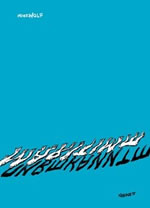
Maritime Unbekannte
by Heinz Wolf
A surreal and strange tour de force by another Viennese comics artist. Heinz Wolf is a long time comics artist and activist in Vienna, he’s working together with Nicolas Mahler on Kabinett Passage, which is a small passage at the Viennese Museumsquartier, a small space dedicated to comics where they have two very small glass display cases where they show comics exhibitions and sell comics in a specially constructed comics vending machine directly to the passing public. Heinz has been around a long time in the comics scene here, but he has mostly been published in indie anthologies and self published efforts. Molch, a weird and heady crime comic scripted by Mahler, is his only work that was published by a professional publisher, Luftschacht. He’s an incredibly dynamic cartoonist, quite funny, and his story telling pacing is really good. He has some francobelgian influences - maybe Franquin - in his style and I also see remnants of people like Harvey Kurtzman, that dynamic MAD - kind of style with a lot of punch, but there’s also some underground-crumb-like grit in there and also this semi-elegant fluent humorous line (not sure if I’m making sense here). He is really good, one of the very best here. He likes Jacques Tardi quite a bit.
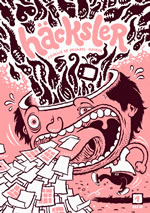
Häcksler
by Michael Hacker
A young talent to watch out for. Häcksler is black undergound humour and consists of various wordless short stories and one pagers, stylistically in the vein of American alternative cartoonists like Dave Cooper and Peter Bagge. Michael is quite young, in his twenties, working as a graphic designer and illustrator, he completed a specific education for this job (not university, some specific higher level school that you do after a -levels). He’s a very nice guy, very much into music and he also does a lot of gig posters for rock concert. He’s quite a fan of metal music of all kinds which shows in his dark humour.
Denmark
Selected by Matthias Wivel
Matthias Wivel is currently completing his PhD in art history at the University of Cambridge.
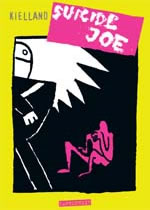
Suicide Joe
by Peter Kielland
Without question the most significant Danish comic of 2010 is from 1984. Published with a delay 26 years, Peter Kielland’s Suicide Joe is a lost classic of the Danish underground. 20 oversized pages of dark mayhem following an Artist and his struggles with ART, MONEY, LIFE, DEATH, SEX, as the crassly rendered, punked-out pages proclaim it to the world in their Babel of tongues (everyone should be able to read and understand). Kielland is one of the godfathers of the current new wave in Danish comics, and this is as emphatic and compelling a manifesto of young art as one could wish for. Its publication in today’s drastically different comics landscape is, in a way, serendipitous in that it reminds the young graphic novelists not to rest on their laurels, but rather to write with ambition.
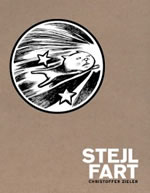
Stejl Fart
by Christoffer Zieler
Prominent in this new generation, Christoffer Zieler is responsible for the other major Danish release of the year. Stejl Fart (“Steep Speed”) is a collection of his eponymous single-panel (though occasionally also sequential) cartoons as published for the last few years on his website (some of it in English!) and, for a while, in the weekly Weekendavisen. Zieler is intellectually curious and couples a dry wit with a wry knack for exposing the moral shortcomings and social foibles of his times. His rendering, though somewhat slick, is animated by an odd gnarlyness and sense of pictorial timing that renders his gags, in a word, hilarious.

676
Edited by Steffen Maarup
Aben Maler
Lastly, in 2010 Danish comics waved goodbye to one of its most fertile publication platforms, Aben Maler’s 676 series. Editor Steffen Maarup decided it was time to try something else and closed down this series of 22-page minicomics, in which a remarkably varied range of cartoonists and illustrators have published some of the most inspiring Danish work of the last few years. This year saw strong contributions to the series from Johan Krarup, Philip Ytournel, Mikkel Sommer, Ina Korneliussen and, again, Peter Kielland—this time with a brand new comic, appropriately entitled Happy End. The 676 series has been a revitalising force on a small comics scene prone to apathy. It will be missed.
Germany
Selected by Christian Gasser
Christian Gasser is a swiss fiction-writer and journalist who reviews comics for various newspapers (NZZ etc.), magazines and radiostations (DRS, WDR etc.) in Switzerland and Germany. He is also the co-publisher and editor of the comics-magazine STRAPAZIN. His latest book was the short-story-collection “Blam! Blam! Und Du bist tot! Super- und andere Antihelden” (2007). He is currently writing a novel and a book on swiss animation-movies.
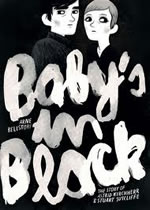
Baby’s In Black:
The Story of Astrid Kirchherr & Stuart Sutcliffe
by Arne Bellstorf
Reprodukt Verlag
In his second graphic novel Baby’s In Black, Arne Bellstorf looks back on the formative years of the Beatles in Hamburg - and focusses on the tragical romance between their first bass-player Stuart Sutcliffe and the photographer Astrid Kirchherr (the girl who shot the first professional Beatles-pictures and is responsable for their hair-dos). Bellstorf based his script on his long conversations with Astrid Kirchherr and melts the two storylines into an atmospherically rich evocation of the burgeoining subcultures in the early 1960s, when artists and designers like Klaus Voorman and Astrid Kirchherr were electrified by the sound of the five charming lads from Liverpool, but had to mingle with rough seamen, smalltime crooks and hookers in dark and smokey bars to see their shows. Baby’s In Black is about early rock’n'roll, dreams of success and fame, early excesses, drug-abuse and love - but it’s also about coming of age in the early sixties and about an emerging youth culture between rebellion, bohemia and adjustment. Bellstorf’s reduced, at times even understated black-and-white-style with dark and sometimes smudgy shades serve the atmosphere of his well-told tale - although his drawings make it sometimes difficult to tell the characters apart, since they all have dark hair, wear black sweaters and look kind of cute.
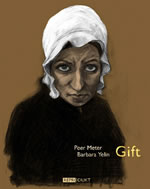
Gift
by Peer Meter & Barbara Yelin
Reprodukt Verlag
Between 1813 and 1827, Gesche Gottfried killed fifteen people in Bremen - among them her husbands, her parents, and her children - with a mixture of rat-poison and butter. To approach one of the earliest, but to this day most intriguing cases of a German serial killer, writer Peer Meter (the writer of historical books on this case) has of course studied all available historical sources, including the official records of Gottfried’s trials. But Gift is neither a mere serial-killer-story nor a dry historical study: Meter and Yelin don’t focus on the actual crimes, but on society. Their narrator is a young female journalist who visits Bremen to make researches for a travelguide about Bremen. She arrives there a couple of days before Gesche Gottfried’s hanging - and of course, since Gottfried is the talk of the town, she gets drawn into the murderess’ story. In order to understand Gesche Gottfried, she talks not only with her relatives and neighbours, but also with politicians, a doctor, a prison ward, lawyers and a priest. But she is confronted with a wall of silence, of half-truths and contradictory information and opinions, she is also confronted with good old 19th Century misogynism, and menaced with physical violence if she doesn’t stop her inquiries. The perspective of a 19th century woman allows Peer Meter and Barbara Yelin to evoke an oppressive panorama of a self-contented bourgeoisie which is corrupted by hypocrisy and bigotry, where justice, politics and church work hand in hand - and are obviously not really interested in understanding the case. Yelin’s drawings - dark, smudgy, dirty, and full of shades and shadows - create an oppressing atmosphere, which serve the writing extremely well. In the end, Gesche Gottfried has to pay for her crimes, but her reasons stay in the dark, hidden in her soul and in Barbara Yelin’s drawings.
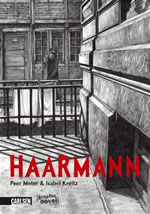
Haarmann
by Peer Meter & Isabel Kreitz
Carlsen
Peer Meter used to write comics in the late 1980s, then vanished from the scene until his comeback this year with six projects with six artists. The second of this series is a story about another german serial-killer, Fritz Haarmann (1879-1925), who lived in Hannover and killed 24 young men. It’s a gruesome tale, in which the Hanover Police Department plays a bizarre role, Haarman being their informant for years. Again, Meter, with the help of the wonderful skills of the artist Isabel Kreitz, tells a story not only about a series of killings, but of a whole city and society in a specific period of history.

Alpha Directions
by Jens Harder
Carlsen Verlag
Jens Harder doesn’t need more than 350 pages to tell a story which covers 14 billion years: the story of our planet from the Big Bang to the appearance of the first hominids. Statistically, this means 7 million years per panel. Alpha Directions (which came out in France already in 2008 but found a German publisher only last year and has won quite a few awards since, among others at the comic-festivals of Angoulême and Erlangen) is a graphic tour de force about evolution. It’s a vertiginous, extremely rich and dense trip through time and space and visualises the complicated and convoluted story of our planet, the story of earthly life which was more than once interrupted by setbacks, destruction, even annihilation. And thus, Harder makes visible how fragile and coincidental all life, all evolution, is. In Alpha Directions Harder cleverly combines natural sciences with mythologies from all over the world and human imagination into an extraordinary comic-adventure about the biggest of all stories - and which, incidentilly, becomes a very powerful pamphlet against creationist aberrations. Possibly Alpha Directions is simply too big for a small review, and Jens Harder’s pictures are bigger than any words. So let me put it very simply: Alpha Directions - which is the first book of a trilogy which will lead Jens Harder and his readers far into the future - is stunning and mindboggling. If you haven’t seen it yet, you’ve never seen anything like that. And if you’ve already seen it, you probably couldn’t help buying this book - whether you understand German or not.
Italy
Selected by Matteo Stefanelli
Matteo Stefanelli is a media researcher and consultant based at the Università Cattolica of Milan and co-author of Il Secolo del Corriere dei Piccoli (Rizzoli).
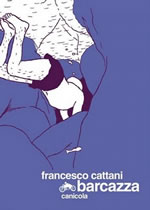
Barcazza
by Francesco Cattani
Canicola
Cattani’s first book is a subtle story about details, set on a boat - for a family vacation - during a hot summer. Letting our eyes float in blank spaces and white silences, we hear the sounds of gutters, slamming doors, sweating skins and all that parts that tell us about the enigma of the daily erosion of life. An almost wordless meditation, beautifully drawn, some where between Anders Nilsen and a pre-raphaelite elegant sense of gestures.
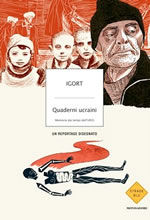
Quaderni ucraini
by Igort
Mondadori
The most sensitive work by Igort is one of the best ethnographies and recalls of Soviet Union’s past, melting travelogue, memoir, and a bit of comics journalism. The tremendous Ukrainian famine - Holodomor - is the fil rouge among people encountered by the artist, and the exploration of their memories is a journey inside despair and vital strength, in a de-humanized condition planned by the regime. Igort’s idiosyncratic nostalgia breaks into reality, and comes out as a powerful way of seeing-by-drawing.
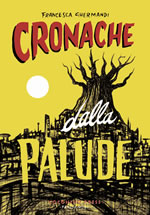
Cronache Dalla Palude
by Francesca Ghermandi
Coconino Press
A young, ugly and sick (Hyperhidrosis: she sweats too much) comic artist is scared by people in a polluted city surrounded by a swamp. Ghermandi renews her mastery in character design, and throw us on a ride to the dark side of eco-friendly discourses, following a rogue gallery of grotesque inhabitants, and an illustrator struggling for hope (with the help of some sarcastic comics insertions, about self-fiction). Nonsense in terms of traditional plot, but full of meaning as gorgeous (and witty) worldbuilding: the playful way of a true imagineer.
Russia
Selected by Dmitry Yakovlev
Dmitry is the director of the Russian comics festival, Boom Fest, which has been running since 2007.

Doodle’s Book
by Zakhar Yaschin
A one-page comic about a simple guy who reflect about what’s going on in his worthless life.
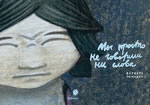
We Just Did Not Say A Word
by Varvara Pomidor
The artist’s book, in which appear the words, to transfer the full force of the images (not really comics).

Bitch
by Andrey Tkalenko & Elena Voronovich
Russian fiction, based on the world of stalkers and telling about the near future of Moscow.
Spain
Selected by Alfons Moliné
Alfons Moliné is a Spanish animator and comics expert who recently launched his fifth book about Japanese woman manga artist Rumiko Takahashi. He also works as a translator.
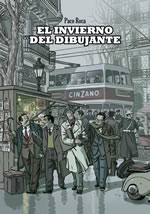
El Invierno Del Dibujante
(The Cartoonist’s Winter)
by Paco Roca
Astiberri
Roca, best known for his multi-award winning graphic novel Arrugas (Wrinkles) about an old man suffering from Alzheimer’s disease (soon to be adapted into an animated movie), brings us a ‘comic about the comics’ in the same vein than Will Eisner’s The Dreamer or Carlos Giménez’s Los Profesionales. Based on a true story, El Invierno Del Dibujante takes us to Barcelona in the year 1957, when five artists who worked for Editorial Bruguera, Spain’s largest comic book publishing company, decide to become independent by abandoning their exploitative employer and launching their own humor weekly, Tio Vivo, in order to get better working conditions and more creative freedom. But the publishing giant will try any tricks to annihilate the newly-created magazine and recover the rebel cartoonists. An enlightening, heartwarming at times and well-researched 128-page chronicle of a little-known period of the history of Spanish comics (Roca used a lot of documentation for his work, even interviewing surviving members of the Bruguera staff), coinciding with a period in which the darkest days of Franco’s dictatorship were over by then and most people were starting to perceive glimpses of liberty… like our five protagonists.

Miguel: 15 Años En La Calle
(Miguel: 15 Years In The Street)
by Miguel Fuster
Glénat
Like El Invierno Del Dibujante, this graphic novel is also based in real life: Miguel Fuster was a competitive comic book artist during the 70s and 80s, working for various international clients (mainly for British girls’ comics). However, the loss of his home due to a fire, a breakup with his spouse and, especially, problems with alcohol, led him to become homeless and live in the streets of Barcelona. The 72-page album is divided into four chapters - linked by some pages with hand-written texts from the author - in which Fuster recalls his 15-year urban odyssey during which he had to survive day by day in absolute loneliness. Eventually, thanks to the help of a volunteer foundation, he was able to vanquish his alcoholism and return to a normal situation. The sketchy, shady artwork matches perfectly with the poignant script, resulting in a truly interesting example of use of comics as a social denunciation tool. Now recovered from his grim past, Fuster is currently dedicated to painting and has his own blog (in Spanish).
Sweden
Selected by Fredrik Strömberg
Fredrik Strömberg is the author of many books about comic art and history, including Black Images In The Comics, The Comics Go To Hell and Comic Art Propaganda. He is director of the Malmo comics festival and comics school, and editor of the long- running Swedish comics culture magazine Bild & Bubla.
2010 was a really good year for Swedish graphic novels. You could actually feel the artistic growth, the widening of scope, the heightening attention from media and so on. Picking the best of the best from this interesting year is not easy, but here are some of my favourite, original Swedish graphic novels from 2010. It was a really strong year for Swedish comics. If you are able to read Swedish, go order these books. If not, get the two volumes of From The Shadow Of The Northern Lights, where all these artists have contributed. If you are a publisher abroad, contact the creators and their publishers, now - before someone else does!
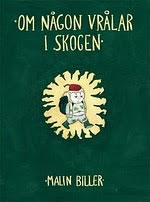
Om någon vrålar i skogen
(If someone screams in the forest)
by Malin Biller
Optimal Press
The first book will have to be Malin Biller’s Om någon vrålar i skogen, which I have no problem announcing as the best original Swedish graphic novel of 2010. Biller is well known for her syndicated humorous strip Biller, but this is a different thing altogether: an autobiographical tale of growing up, being the outsider, watching your family disintegrate and, not least, being sexually abused by your father. This is a powerful story indeed, but not a sulky one, not a pointed finger at the wrongdoers, and, despite the theme, not a depressing read. Biller is a humorist at heart, and as such, she manages to make the read a pleasant one, adding many really enjoyable parts to her, sometimes rather bleak, story. Still it is revealing, harrowing and quite an experience to make it through the whole story.

Fiskarna i havet
(The Fish in the Sea)
by Anneli Furmark
Galago
I’m too old to be a fan, but there are authors I keep track of and avidly await each and every new book of. Swedish Anneli Furmark is one of those artists. Since her book début about ten years ago she has never let me down; always delivering thoughtful, mature tales of real people and real relationships. She has also an unnerving sense for drawing people and scenery with just a few lines but never resorting to the often imitated, iconic imagery of so many comics out there.
Fiskarna i havet (The Fish in the Sea) is a natural development of Furmark’s career. It is her first full-length graphic novel and she has also hand coloured the whole book with casual and at the same time precise, earthy water colours that matches her drawings perfectly. The main part of the story retells what is described in the diary of a young woman studying at an art school on an island in the Swedish archipelago, her head full of existential worries, seeking both seclusion and closeness from her fellow students and teachers. If this sounds puerile, I can attest that it is not. Fiskarna i havet is a beautiful and, I hate to use this word again, mature graphic novel, and it leaves you thinking about the characters long after you’ve read it through, which to me is the sign of a really good story.
For those of you not fluent in Swedish, you can find shorter stories by Furmark in both volumes of the anthology From the Shadows of the Northern Lights and in Drawn & Quarterly Showcase #5. Fiskarna I havet has already been translated in to French, but sadly not yet into English.
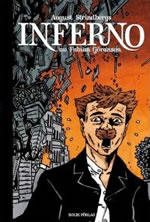
August Strindbergs Inferno
(August Strindberg’s Inferno)
by Fabian Göranson
Kolik Förlag
Normally I’m not much of a fan of comics based on literature, film and so on, as this is almost always disappointing, compared to the original or just compared with original comics. And then there are the exceptions, like Fabian Göranson’s comics version of August Strindberg’s novel Inferno. The Swedish artist Fabian Göranson has used the world-famous author August Strindberg’s (in)famous novel/dairy Inferno as the starting point for this graphic novel. This is far from a dull Classics Illustrated, though. GUouml;ranson is one of the most interesting Swedish comics artists today, and his version of Strindberg’s novel is a piece of art all in itself.
Inferno is a strange novel to start with, combining the diary of a person heading straight into a a delusional state of paranoia and ideas occultism and Swedenborgianism with a formal treatment of story and language that makes many refer to Inferno as the first truly modern Swedish novel. Göransson manages to add to this, using the visual language of comics to enhance the feeling of mentally heading for Hell, using many quite graphic story-telling devices normally associated with more “low brow” comics. All in all a great book, showing that it is possible to use a novel as a starting point for a comic, without making it into a boring exercise of trying to be as “true” as possible to the original.
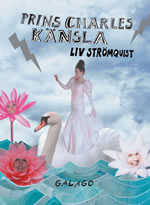
Prins Charles känsla
(Prince Charles’ Feeling)
by Liv Strömquist
Galago
The new, critically acclaimed book by everyone’s darling, Liv Strömquist, telling it like it is. Sweden’s most didactic feminist cartoonist, who at the same time manages to be one of the funniest. In her latest book, she continues her relentless search for truths about the way we view the relationship between men and women. Educating and fun at the same time. Sadly, Stömquist’s books are not available in any other language other than Swedish, yet.
Posted: January 23, 2011












